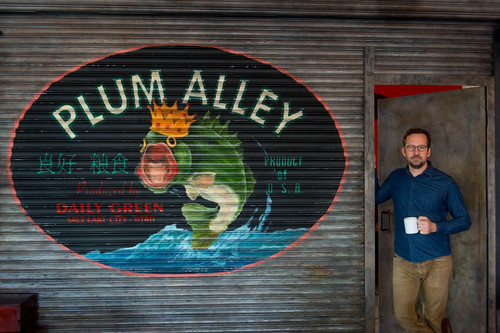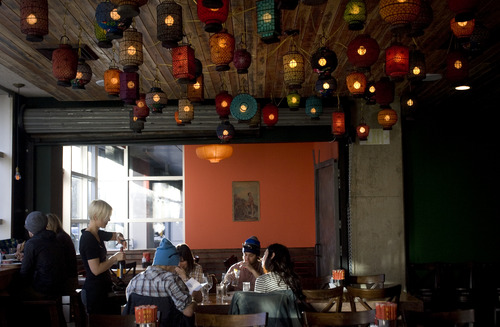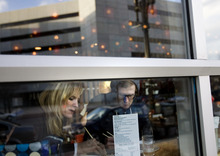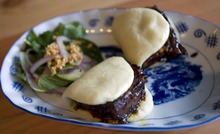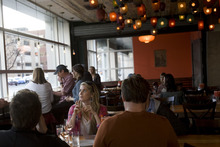This is an archived article that was published on sltrib.com in 2014, and information in the article may be outdated. It is provided only for personal research purposes and may not be reprinted.
There aren't many Salt Lake City business owners with enough confidence to pack up a nationally recognized restaurant at the height of its popularity and shelve it for an unknown length of time.
Except Ryan Lowder.
The chef plans to close Plum Alley so he can transform the space at 111 E. 300 South into a bar and restaurant. The last day of business at the Asian-inspired restaurant will be Saturday, Feb. 1.
After that, construction on the new Copper Common will begin.
Lowder had hoped to move Plum Alley to another space, but hasn't found a downtown location that matches the concept. So he'll wait for the perfect spot.
"I want to keep Plum Alley alive," he said during a recent interview with The Tribune. "But we've created this identity and we can't just put in any box."
—
Change of plans • It's not what Lowder planned in 2011 when approached about taking over the space on the corner of 300 South and Edison Street (145 East). He immediately envisioned a bar that would complement — as well as handle overflow from — The Copper Onion, his first restaurant, to the west.
Several months into construction, Lowder learned that getting a club license from the Utah Division of Alcoholic Beverage Control (UDABC) would take more than a year.
"When I realized I couldn't have a bar, I shifted gears and did Plum Alley," he said. He researched the area and its history, ultimately settling on the historical name Plum Alley — the street where Salt Lake City's Chinatown once stood. Decorated with communal tables, retro posters and colorful paper lanterns, the restaurant serves a menu of house-made ramen, steamed pork buns and other Southeast Asian fare.
It has received positive reviews locally and nationally, including being named one of the top 50 new restaurants of 2012 by Bon Appétit magazine.
"We had to throw it together so quickly," he said. "But it turned out to be a good concept that's done well."
As if packing up one restaurant and creating a new one weren't enough, Lowder has also been working on two other projects.
He recently leased space in a new Holladay development on 2300 E. Murray Holladay Road, where he plans to open a restaurant that serves hand-made pizza and pasta.
Lowder also has set up a restaurant production kitchen near 900 South and 700 West, large enough to make ice cream, bread, pasta and some cured meats and cheeses for all of his restaurants. It has a walk-in cooler for butchering whole animals and space outside for a garden and greenhouse.
He said while his rapid expansion might seem like a gamble to outsiders, he believes as a business owner he owes it to his staff — which now numbers about 80 — to expand when it makes sense.
"I have good people who work here," he said. "I want to provide more opportunities for them."
—
Local boy makes good • Lowder's success is a classic "local boy made good" story. He grew up in Sandy, attended the Culinary Institute of America and worked at various restaurants in New York City and Barcelona, including Jean-Georges, Mercat, Gusto and Born Cooking. Then he decided to return to the West.
"I had always intended to go to Portland," he said. But while visiting family in Utah, he discovered Salt Lake City's burgeoning food scene, from the downtown farmers market to restaurants such as Pago, Bambara and Takashi.
Along with wife Colleen, Lowder returned to Salt Lake City in 2010 to open The Copper Onion next to Broadway Centre Cinemas.
Since then, he has impressed those in the food and business communities.
"He is incredibly talented with food, but also an incredibly smart businessman," said Jason Mathis, executive director of the Downtown Alliance.
Mathis said part of what makes Salt Lake City's downtown food scene work is the close working relationships among chefs who benefit from each other's accomplishments. "Ryan has been a critical piece of what makes that so successful."
Mathis, like many food fans, will miss Plum Alley: "I"m kind of addicted to the ramen," he said. But he knows when it reappears, it will be a good fit. "Ryan has consistently hit it out of the ballpark, so I have every reason to believe the next venture will be a wild success."
—
Back to Plan A • The decision to change Plum Alley came about six months ago, when Lowder finally was granted the hard-to-come-by club license from the UDABC. He decided it was time to "turn the space into what I originally envisioned."
No wonder Rachel Hodson, who designed the interior for Plum Alley and is overseeing the remodeling, called Lowder a "serial entrepreneur."
"Ryan has worked in many places and countries and there's a lot of value to that," she said. "He has seen what makes things work or not work in a lot of different settings."
The Copper Common interior is inspired by Thomas Edison's laboratory in Menlo Park, N.J., a nod to the street sign in front of the Salt Lake building, said Hodson, who also is co-editor and owner of Salt Lake's Edible Wasatch magazine.
While the kitchen will stay put, everything else will change, from moving the entrance to adding a 22-foot bar designed by an Old World millworker. The bar will offer wine, beer and cocktails as well as a menu of small plates and entrees. Look for an oyster station and probably a few holdovers from Plum Alley, including the beloved pork-belly buns.
Lowder hasn't set a firm opening date, but his goal is late February.


